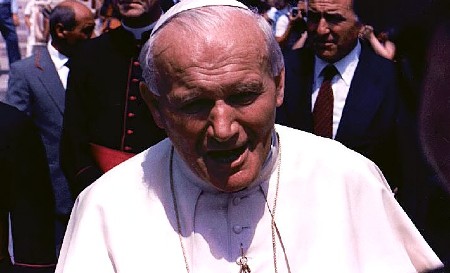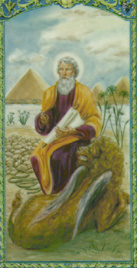We ask you, humbly: don't scroll away.
Hi readers, it seems you use Catholic Online a lot; that's great! It's a little awkward to ask, but we need your help. If you have already donated, we sincerely thank you. We're not salespeople, but we depend on donations averaging $14.76 and fewer than 1% of readers give. If you donate just $5.00, the price of your coffee, Catholic Online School could keep thriving. Thank you.Help Now >
Power and Grace: The Patron Saints of Europe
FREE Catholic Classes
During these heated debates about the crucifix in classrooms, Italy issued a visually sumptuous reminder to the European Union of the Christian roots of every nation in Europe, and of the continent itself.
We ask you, humbly: don't scroll away.
Hi readers, it seems you use Catholic Online a lot; that's great! It's a little awkward to ask, but we need your help. If you have already donated, we sincerely thank you. We're not salespeople, but we depend on donations averaging $14.76 and fewer than 1% of readers give. If you donate just $5.00, the price of your coffee, Catholic Online School could keep thriving. Thank you.Help Now >
Highlights
ROME, Italy (Zenit.org) - Italy no longer crusades with armies, but with a far more powerful weapon, her long-standing tradition of art and culture. During these heated debates about the crucifix in classrooms, Italy issued a visually sumptuous reminder to the European Union of the Christian roots of every nation in Europe, and of the continent itself.
"Power and Grace: The Patron Saints of Europe" is a unique exhibition on display in Rome in the Palazzo Venezia until Jan. 31. Over one hundred works by artists ranging from El Greco to Hans Memling, Caravaggio to Mantegna and Titian to Murillo stand side by side with Eastern icons and snippets from the most famous films about saints.
The show -- co-sponsored by the highest level of Italian government and the Church hierarchy -- was opened by Prime Minister Silvio Berlusconi and Cardinal Tarcisio Bertone on Oct. 7 (incidentally the feast of the Holy Rosary and the commemoration of the battle of Lepanto, where secular and Church forces fought side by side to save the Christian life of Europe from Turkish aggression).
Archbishop Gianfranco Ravasi, president of the Pontifical Council for Culture, wrote the opening essay of the catalogue with a provocative question. Echoing Albert Camus, he asked, "Can one be a saint without God? Is it enough to be a person of good will?"
Archbishop Ravasi's answer is a resounding "no." Grace, he writes, the fullness of faith, is essential for sainthood. Backing up his claim are 20 centuries of men and women from the first martyrs to Blessed Mother Teresa of Calcutta, whose extraordinary lives and deeds were accomplished through their cooperation with God's grace.
Even more astounding than the exquisite copy of a stained glass window from the Le Mans Cathedral, were the opening words on the didactic panels: "The history of Christian sainthood and the social, cultural and political history of Europe are closely connected." The power of saints, they write, is "a link between heaven and earth."
The first room is dedicated to Mary, Mother of God. Glowing stained glass, a tender Russian icon of Mother and son and the dazzling vision by Murillo of the Immaculate Conception testify to Europe's Marian devotion across both space and time.
The witness of the martyrs, particularly St. Peter, fills the next room, but pride of place goes to St. Martin of Tours, whose feast day was Wednesday. Martin bears special distinction as the first saint who was not martyred. Hermit, abbot, bishop and missionary, St. Martin lights the way for a world of legalized Christianity where without persecution, men and women must find ways to live like Christ.
We ask you, humbly: don't scroll away.
Hi readers, it seems you use Catholic Online a lot; that's great! It's a little awkward to ask, but we need your help. If you have already donated, we sincerely thank you. We're not salespeople, but we depend on donations averaging $14.76 and fewer than 1% of readers give. If you donate just $5.00, the price of your coffee, Catholic Online School could keep thriving. Thank you.Help Now >
Monasticism is the next form of sanctity explored in the exhibit. St Benedict, whose vow of stability gave order in the chaos wrought by the fall of Rome, is featured side by side with Caravaggio's meditative St. John the Baptist. Hans Memling's exquisitely painted portrait of the saint shows Benedict reading his Rule, which, according to the exhibit, would be "the instrument for preserving the knowledge, texts, customs, techniques and values of ancient civilization."
The development of the cult of the saints through miracles and memory is rendered through touching ancient testimonies painted on antique panels, but also in a startlingly large canvas by Russian painter Illarion Michaijlovic Prjanisnkov from 1887. Called "The Day of the Savior," the work uses bright colors of the devout procession to brighten the leaden sky hanging above, and recalls Russia's long tradition of faith. This same section also features St. Nicholas of Bari, beloved by both Eastern and Western Europe.
The beloved mystics of Europe are prominently rendered as well. Jan Van Eyck's delicate panel illustrates St. Francis receiving the stigmata, while St. Catherine of Siena, patroness of Europe, is depicted on small panels to large canvasses.
St. Stanislaus of Poland leads the homage to bishops and missionaries, who brought the Word of God to the lands of Europe. St. Stephen of Hungary and St. Louis of France set examples of how men in possession of supreme temporal power can live lives of exemplary holiness.
The combination of temporal authority and sanctity is a volatile one, however, and this tension is likewise depicted in the exhibition. Threats encroach on the freedom of the Church both through the stifling of religious freedom and through the corruption of religion. Peter Glenville's 1964 film "Beckett" plays overhead, showing the Archbishop of Canterbury executed by King Henry II's assassins.
The show closes in homage to St. Thomas More, whose portrait by Hans Holbein seems to meditate on the images of the 1966 film "Man for All Seasons" by Fred Zinneman. The didactic panel comments on this sad chapter with these words: "This exhibition leads to the conclusion that the balance between power and grace depends on the principle of religious freedom, which is the criterion for properly understanding the principle of the secularity of the state. This involves recognizing the dignity of human beings in whom consciences are borne freely and according to reason; these are responses to God, which no power can induce or prevent."
These words, seemingly from the lips of the hundreds of European saints depicted in the exhibit, speak more convincingly than the judges from the European Court of Human Rights.
-----
Elizabeth Lev teaches Christian art and architecture at Duquesne University's Italian campus and at the University of St. Thomas' Catholic studies program. She can be reached at lizlev@zenit.org
 Hi readers, it seems you use Catholic Online a lot; that's great! It's a little awkward to ask, but we need your help. If you have already donated, we sincerely thank you. We're not salespeople, but we depend on donations averaging $14.76 and fewer than 1% of readers give. If you donate just $5.00, the price of your coffee, Catholic Online School could keep thriving. Thank you. Help Now >
Hi readers, it seems you use Catholic Online a lot; that's great! It's a little awkward to ask, but we need your help. If you have already donated, we sincerely thank you. We're not salespeople, but we depend on donations averaging $14.76 and fewer than 1% of readers give. If you donate just $5.00, the price of your coffee, Catholic Online School could keep thriving. Thank you. Help Now >







 Daily Readings for Thursday, April 25, 2024
Daily Readings for Thursday, April 25, 2024 St. Mark: Saint of the Day for Thursday, April 25, 2024
St. Mark: Saint of the Day for Thursday, April 25, 2024 Prayer for Policemen: Prayer of the Day for Thursday, April 25, 2024
Prayer for Policemen: Prayer of the Day for Thursday, April 25, 2024

